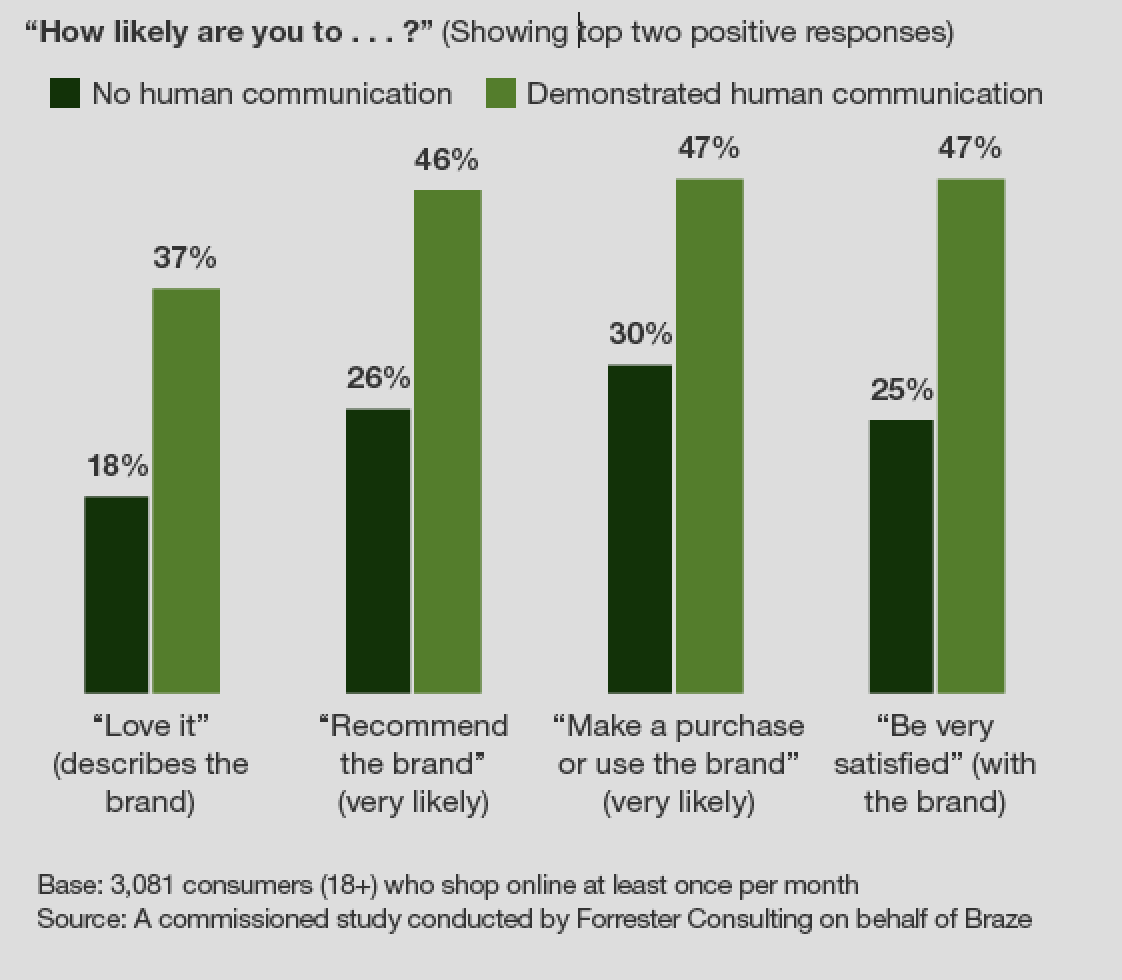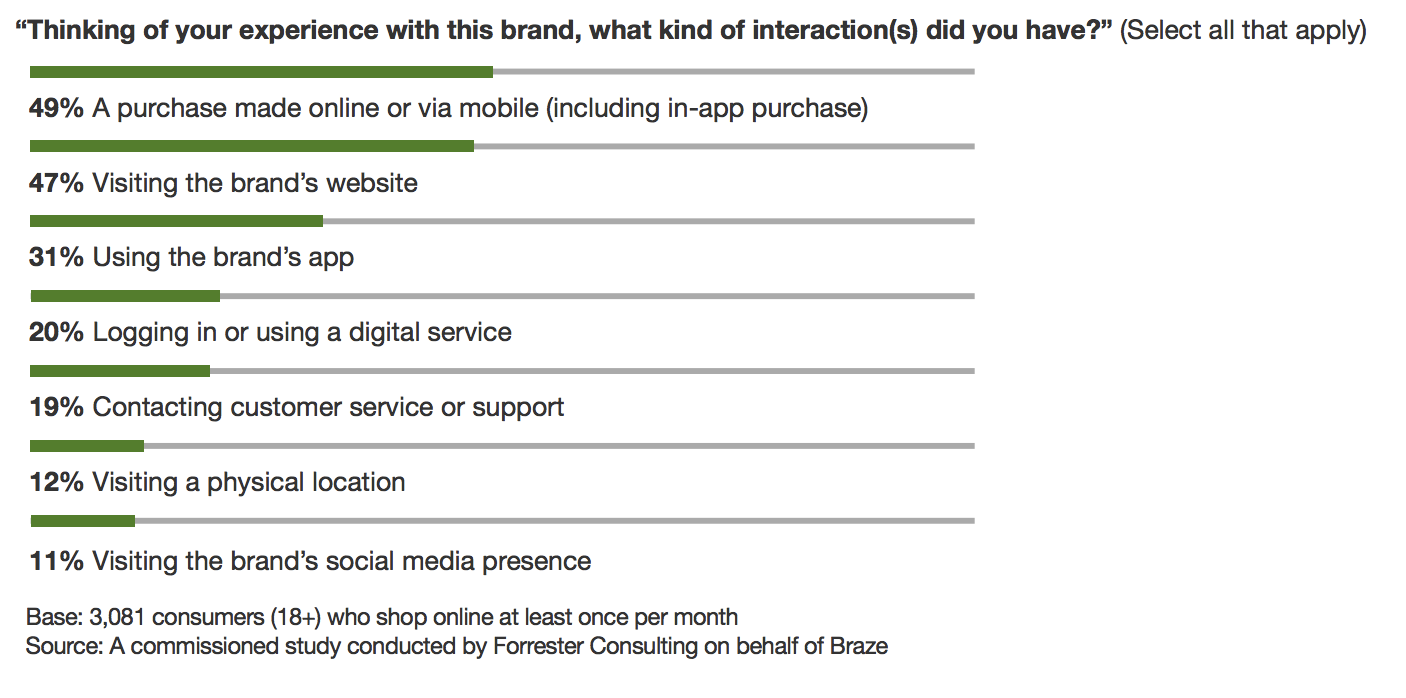Robots, machines, and algorithms do some amazing things, but building brands isn’t one of them. Only people build brands.
So why read about and have conversations about ‘humanizing your brand?’
Because too many companies are failing to build a human brand and they’re losing the battle to those that do.
Braze, makers of a customer-engagement platform, wanted to dig deeper into this subject, so they commissioned Forrester Consulting to help create the study How Human Is Your Brand? This involved surveying more than 3,000 consumers in three global regions.
The bottom line on brand humanity
The study’s a little technical and jargon-filled, but it sheds light on some important insights.
We’ll begin with what Forrester claims are the benefits of brand humanity:
Brand humanity fosters high-value customer relationships Every company wants that, right? The study proclaims that high-value customer relationships contribute to positive outcomes, including:
- Brand sentiment
- Purchase intent
- Satisfaction
- Likelihood to recommend
You can win these prized outcomes by achieving high marks for what the study’s authors call the ‘Brand Humanity Index.’

How likely are you to love, recommend, purchase and be satisfied with a brand? Those are the questions in the brand humanity index. The answers reveal how heavily brand humanity weighs into the answer. Forrester crunched these numbers and found:
“Consumers are 57% more likely to be loyal to a brand that demonstrates human communication.”
The emotions that drive brand humanity
What emotions drive consumer perceptions of humanity? The survey’s respondents made it clear that brands were most effective in driving humanity when they were being useful, helpful and reflecting a willingness to meet their needs.
Leading emotional drivers stacked up like so:

Interestingly, consumers indicated brands need not strive to entertain. Emotional attributes, including exciting, amusing, and fun, were weak indicators of brand humanity. Consumers are more interested in substance.
The functional characteristics of brand humanity
What actions can your brand take to demonstrate and reinforce the message that it is a human brand? To answer this question the study created three categories of actions:
1. Natural Communication This demonstrates that a brand communicates clearly and naturally. It involves:
- Speaking like a normal person
- Using a tone appropriate for the customer’s preferences and the situation
- Sending clear and easily understood messages
2. Being Considerate This shows that a brand cares about its customers’ needs. Considerate brands demonstrate they:
- Value their customers’ time and business
- Are responsive to their customers’ needs
- Put the convenience of their customers before their own
- Understand and use a customer’s preferred channel or contact method
The study expanded on the final point, claiming strongly considerate brands grasp opportunities to connect with customers on their terms, be it via text, chat (human or bot), email, push notifications, call centers, etc. Brands must work across these channels in a seamless fashion to deliver a consistent and cohesive customer experience.
3. Personal communication Brands win customers over when they understand what’s important to the customer in real-time and deliver messages in context. Personal communication isn’t the most powerful predictor of brand humanity wins, but according to the study, it is the most significant driver of customer purchase and satisfaction.
Think omni-channel
Understanding that your brand can differentiate itself with its customers by making the customer experience more human is a great start. You must also recognize, however, that your customers will evaluate your brand regardless of when, where and how the contact occurs.

The most memorable brand interactions occur with online purchases and website visits, but they’re not the only instances that make an impression.
The one-two punch for driving human connections
The Forrester study found that none of the firms interviewed had a specific strategy in place to drive human-like experiences. But two factors surfaced as consistent themes for driving better marketing results and improving the customer experience:
- Your people. Not surprisingly, people humanize your brand. They do so via all types of interactions, be they in-person, on the phone, or via digital channels.
- Customer empathy. The report states: “Your brand’s humanity will shine only as bright as your customer empathy allows.”
Five ‘humanizing’ recommendations
The report concludes by offering five keys to differentiating your brand and building lasting emotional connections with your customers:
- Focus on the people you serve. Maintain a clear line of human communication between your brand and its audience to create tangible business value.
- Find your customer’s emotional cues. You need the right combination of brand emotions and actions to deliver human communication.
- Let empathy guide your efforts. While you must rely on data and analytics, you must put all the bits and bytes into context. The best brands are customer-obsessed and their commitment to empathy shapes their corporate culture and employee selection.
- Keep machines in mind. Brands that are able to express humanity through the myriad of digital channels they employ seize a clear advantage.
- Invest in brand humanity. We close this article with the exact words the authors at Forrester used:
“Building brand humanity starts inside with the right investments in the people and culture, then extends outside to ensure the right tools, partners, and capabilities are in formation to take on both the delicate art and high science of human interaction.
Commitment to and investment in brand humanity will engender not only short-term financial results, but it will go a long way to forging a sustained brand personality and equity that the enterprise can bank on for long-term value.”